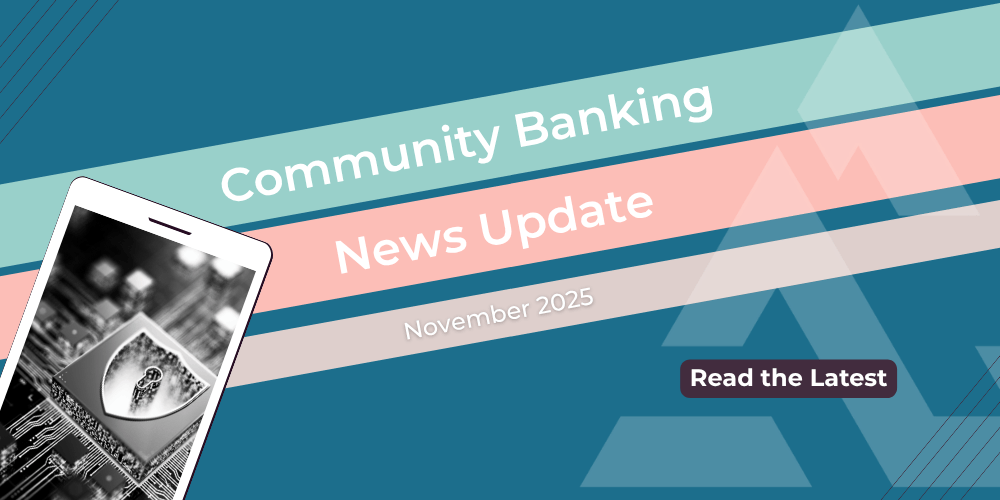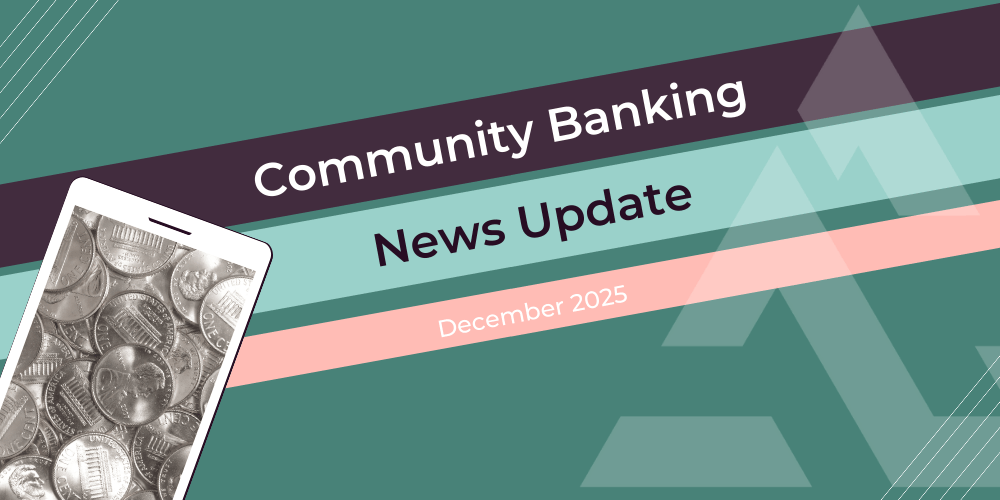The Year in Cross-Border Payments and Correspondent Banking
International wire automation, stablecoins, wallets, and AI reshape global money movement What a pivotal year in cross-border payments. No one...
7 min read
 Daisy Lin, Head of Marketing, Acceleron
:
11/13/25 8:34 AM
Daisy Lin, Head of Marketing, Acceleron
:
11/13/25 8:34 AM

This month’s banking news brings a wave of developments with direct implications for community banks and credit unions. U.S. regulators signal potential capital relief for smaller institutions while urging them to embrace new technology. At the same time, the Fed is cutting supervision and regulation staff, and the CFPB’s cybersecurity program has been deemed ineffective. A federal judge has temporarily blocked the Open Banking rule, and the Federal Reserve has cut interest rates again. Finally, new surveys reveal what’s keeping community bankers up at night, and where they’re placing their bets for growth. Read on for the details.
According to a report from Bloomberg News, U.S. regulators, including the Federal Reserve, the Federal Deposit Insurance Corporation (FDIC), and the Office of the Comptroller of the Currency (OCC), are preparing to propose easing capital requirements for smaller banks by lowering the Community Bank Leverage Ratio (CBLR) from 9 percent to 8 percent. The adjustment would allow qualifying community banks to opt into a simpler capital standard rather than the more complex risk-based framework. Trade groups such as the Independent Community Bankers of America have long pushed for the change, arguing that the current threshold constrains lending and balance sheet flexibility.
If finalized, the proposal would expand lending capacity and reduce compliance costs for smaller institutions, freeing up capital to reinvest in local communities and technology initiatives. However, it also places greater responsibility on community banks and credit unions to manage risk prudently and maintain strong capital discipline in an environment of economic uncertainty and evolving regulatory expectations.
The OCC signaled a more open stance toward digital bank formation with its conditional approval of Erebor Bank, a new national bank backed by investors including Peter Thiel and Palmer Luckey. Erebor plans to offer a blend of digital-asset custody and stablecoin transaction capabilities, along with traditional banking services. The OCC’s decision, granted in just 125 days, is being hailed by some as the start of a new wave of bank charters for technology-driven institutions.
At the same time, the Independent Community Bankers of America (ICBA) filed a formal objection to Coinbase Global’s pending application for a national trust bank charter, arguing that its crypto-centric model and history of cybersecurity issues make it unsuitable for federal approval. The ICBA’s opposition highlights growing concern among community institutions that fintech and crypto firms may gain access to the privileges of the banking system without the same regulatory obligations.
Together, these developments mark a pivotal moment in defining what counts as a “bank” in the digital age. As the OCC signals greater openness to technology-first entrants, community banks and credit unions face both opportunity and risk: opportunities for new fintech partnerships and innovation, but also competitive and regulatory challenges if nontraditional players are allowed to operate under lighter supervision. The outcome of these charter decisions will help determine how the next generation of financial institutions and their oversight will take shape.
Read our Co-founder and Chief AML Officer Sarah Beth Felix’s take on the Erebor preliminary conditional approval.
For more on Genius Act rulemaking and the importance of community FI participation, read our article:
Following the OCC’s recent openness to new bank models, Federal Reserve leaders are sending a similar message: embrace innovation or risk being left behind. Vice Chair for Supervision Michelle Bowman said banks must be able to “engage fully in digital assets if they want to,” so “they’re not left behind,” while ensuring that new activity remains separate from core banking operations to preserve safety and soundness. She cautioned against punitive capital requirements, such as the proposed 1,250% risk weighting for digital-asset exposures, which she said would effectively shut banks out of the market.
Meanwhile, Treasury Secretary Scott Bessent told attendees at the Federal Reserve’s Community Bank Conference that smaller institutions must “go on the offense, retake market share, chase after customers, champion technology, leverage the new regulatory landscape to your advantage.” He emphasized that community banks willing to modernize their technology and appeal to younger customers are best positioned to thrive in the coming decade.
After years of caution, top regulators are now encouraging smaller institutions to engage more actively with digital assets and new technologies. This signals a shift from defensive regulation toward proactive modernization. For community banks and credit unions, the message is clear: embracing secure, compliant innovation, whether in payments, digital assets, or data infrastructure, is becoming essential for long-term competitiveness and relevance.
The Federal Reserve reportedly plans to reduce headcount in its Division of Supervision and Regulation by about 30 percent, shrinking from roughly 500 to 350 employees by the end of 2026 as part of a broad internal reorganization. Banking Dive reports seeing a memo from Vice Chair for Supervision Michelle Bowman, which said the cuts will mostly occur through attrition, retirements, and voluntary separations. The restructuring is intended to streamline oversight, flatten management layers, and improve focus on core priorities.
While the Fed describes the move as an efficiency measure, fewer examiners could mean slower turnaround times, less continuity with supervisory teams, and greater reliance on data-driven or remote examination methods. For community institutions that depend on consistent relationships with regulators, this shift may alter how oversight is conducted and how emerging risks are identified. Community banks and credit unions will need to stay vigilant, maintaining strong internal compliance practices and transparent communication with examiners to ensure they remain well-prepared as supervisory resources become more limited.
Read about the 5 pillars of an effective AML program:
A new audit by the Office of Inspector General (OIG) for the Federal Reserve Board concludes that the CFPB’s information security program has deteriorated significantly, dropping from a maturity level of 4 in fiscal year 2024 to a level 2 in fiscal year 2025. The report flags multiple deficiencies: outdated software that no longer receives vendor security updates, missing authorizations to operate for many systems, use of risk-acceptance memorandums without adequate documented analysis, and a lack of a strategy to monitor evolving cyber-threats. The OIG states that as a result, the bureau “is unable to maintain an effective level of awareness of security vulnerabilities in its environment.” The agency has reportedly accepted the OIG’s recommendations and is working to modernize legacy technology and strengthen incident response.
The breakdown at the CFPB matters to community banks and credit unions because it signals increased systemic risk in the broader ecosystem of consumer finance supervision; weaker oversight and compromised data security can lead to greater regulatory uncertainty and pressure on smaller institutions to step up their own cybersecurity posture. It’s a reminder that community institutions must remain vigilant to ensure their own systems are secure, their third-party vendors are well-governed, and they maintain transparent communication with regulators and auditors to avoid being caught off-guard in an environment where regulatory guardrails may be under strain.
A federal judge issued a preliminary injunction halting enforcement of the CFPB’s “Personal Financial Data Rights Rule,” also known as the open banking rule, until the agency completes its ongoing rulemaking review. The rule, finalized under the prior administration, would have required banks and credit unions to provide customers and authorized third parties access to certain financial account data at no charge and through standardized access protocols. Plaintiffs including the Bank Policy Institute and the Kentucky Bankers Association argued that the rule exceeded the Bureau’s authority, and the judge agreed. The injunction leaves compliance deadlines in flux and pauses enforcement while the CFPB revises the rule.
The court’s decision introduces further uncertainty around the evolving regulatory framework for data sharing, fintech collaboration, and consumer access to financial information. With the rule’s future now unclear, community banks and credit unions can stay vigilant about potential changes in compliance expectations once the CFPB reissues the rule.
The Federal Reserve voted to cut its benchmark federal funds rate by another quarter point to a range of 3.75 to 4 percent, marking the second consecutive reduction this year as policymakers respond to slowing economic growth and easing inflation. In its statement, the Fed cited “clear signs of softening” in labor markets and consumer spending, but reaffirmed its commitment to returning inflation to the 2 percent target over time. Chair Jerome Powell emphasized that while the economy remains resilient, tighter credit conditions and cooling demand justify a “gradual recalibration” of monetary policy. Market reaction was muted, with investors already pricing in a series of cuts through early 2026.
The new target range changes the calculus for funding costs, loan pricing, and balance sheet strategy. As rates drift lower, community banks and credit unions may get some relief on deposit pressure, but they also face renewed margin compression and uncertainty about the path of future cuts. Institutions that rely heavily on interest income will need to lean more on disciplined asset-liability management and explore additional non-interest income opportunities.
Read more about how to increase non-interest income through international payment automation:
BNY’s 2025 Voice of Community Banks survey highlights how closely community banks are tying their future to small business clients and operational efficiency. About 30 percent of the small businesses surveyed already use a community bank, and 55 percent say they plan to begin or expand a relationship with one. Banks that are growing their small business clientele are far more likely to be investing in efficiency and technology, including digitizing manual processes and using AI to improve operations. Looking ahead to 2026, BNY reports that community banks expect to make significant investments in AI, cybersecurity and fraud prevention, digital banking capabilities, and modern payments, with nearly one quarter planning to invest in modern payments and almost half of that group ranking it as a top priority.
The 2025 Conference of State Bank Supervisors (CSBS) Annual Survey of Community Banks shows a similar focus on fundamentals and technology from a risk perspective. Community bankers ranked net interest margins as their top external risk and core deposit growth as the second most important, ahead of economic conditions, the cost of technology, and the cost of funds. Regulatory burden, which has often been a top concern in past years, fell to sixth place. On the internal side, cybersecurity remains the leading risk by a wide margin, followed by technology implementation and related costs, with credit risk moving ahead of liquidity as the third most frequently cited internal concern.
Together, these surveys point to a sector that is increasingly focused on growing small business relationships, protecting margins, and upgrading technology rather than simply reacting to regulatory pressure. For community banks and credit unions, the message is clear: winning the future will depend on strengthening core deposit and small business franchises, investing in payments and digital capabilities, and treating cybersecurity and tech execution as central strategic priorities rather than back-office issues.
Last month brought several major developments for community banks and credit unions. The OCC dramatically reduced regulatory burden for smaller institutions, while JPMorgan plans to charge Plaid for customer data access, and several large bank mergers are taking shape. (Missed it? Catch up here.)

International wire automation, stablecoins, wallets, and AI reshape global money movement What a pivotal year in cross-border payments. No one...

New rules, no pennies, and next-generation rails: this month’s biggest banking news As the year winds down, the industry isn’t slowing. The Fed is...

The SVP, Head of Business Development for Service Providers at The Clearing House talks instant payments, bourbon, and fraud. When you talk to...